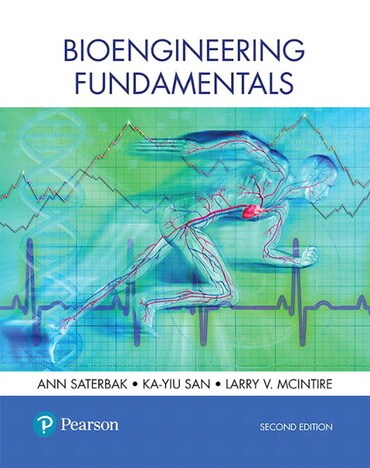
Bioengineering Fundamentals, 2nd edition
- Ann Saterbak |
- Ka-Yiu San |
- Larry V. McIntire |
Title overview
For sophomore-level courses in Bioengineering, Biomedical Engineering, and related fields.
A unifying, interdisciplinary approach to the fundamentals of bioengineering
Now in its 2nd Edition, Bioengineering Fundamentals combines engineering principles with technical rigor and a problem-solving focus, ultimately taking a unifying, interdisciplinary approach to the conservation laws that form the foundation of bioengineering: mass, energy, charge, and momentum. The text emphasizes fundamental concepts, practical skill development, and problem-solving strategies while incorporating a wide array of examples and case studies. This 2nd Edition has been updated and expanded with new and clarified content, plus new homework and example problems.
Hallmarks of the text
- A quantitative engineering approach and exposure to bioengineering technologies and research topics introduces physical variables in the context of bioengineering, as well as the methodology for solving engineering problems that is used throughout the text.
- REVISED! The text has been edited for clarity and to improve readability. Denser sections were expanded to explain concepts more completely, primarily in Chapters 3, 4, and 5.
- Chapter openers discuss a timely bioengineering research or design challenge to expose students to the realities of the field.
- Detailed biomedical applications include three case studies on heart and blood circulation, lungs and a heart-lung bypass machine, and kidneys and dialysis.
- Fundamental concepts and equations are used to demonstrate how conservation laws (including conservation of mass and energy, momentum, and charge) apply to biological and medical systems to lay a foundation for beginning bioengineers.
- A focus on practical skill development aims to assist students in acquiring skills useful in the field, such as: problem formulation and solving; understanding of mass, momentum, charge, and energy conservation equations; the application of conservation equations to problems in the biological and medical sciences, and an appreciation for the field’s technical challenges and opportunities.
- A mastery of conservation principles is supported as students transition from general science and math courses to upper-level bioengineering courses, such as biomaterials and bioinstrumentation.
- A framework of accounting and conservation principles allows students to build a mental model of how key concepts in engineering, chemistry, and physics are interrelated.
Features for student success
- Self-contained chapters and a flexible organisation simplify the process of customising material to fit unique class demands. Instructors can choose to emphasise one or more extensive properties, or to teach from an entirely problem-based learning framework.
- An emphasis on problem-solving strategies uses extensive example problems that are worked out in detail to demonstrate the translation of written problem statements into a diagram.
- NEW! Homework problems have been increased, particularly in Chapters 2 and 6. This improvement gives instructors flexibility in assigning problems, and it gives students additional opportunities to apply their knowledge and practice.
- NEW! Problems have been added to all chapters, including problems that require computational solutions. The topics of the additional problems focus on current areas of biomedical engineering design and application.
- NEW! Additional example problems were added throughout Chapters 1—6, based on feedback from student learners and reviewers. New problems in other chapters were added to illustrate concepts that were not fully developed in the 1st Edition.
- A wide array of examples using actual numerical parameters touch on topics that span the breadth of modern bioengineering, including physiology, biochemistry, tissue engineering, biotechnology, and instrumentation, giving students exposure to current bioengineering technology and research.
Content Updates
- NEW! Homework problems have been increased, particularly in Chapters 2 and 6. This improvement gives instructors flexibility in assigning problems, and it gives students additional opportunities to apply their knowledge and practice.
- NEW! Problems have been added to all chapters, including problems that require computational solutions. The topics of the additional problems focus on current areas of biomedical engineering design and application.
- NEW! Additional example problems were added throughout Chapters 1—6, based on feedback from student learners and reviewers. New problems in other chapters were added to illustrate concepts that were not fully developed in the 1st Edition.
- REVISED! The text has been edited for clarity and to improve readability. Denser sections were expanded to explain concepts more completely, primarily in Chapters 3, 4, and 5.
- UPDATED and EXPANDED! Chapters 1, 2, 5, and 6 have been restructured and expanded with new and clarified content.
- Chapter 1 contains several new or updated engineering case studies.
- Sections 2.4—2.6 lay out the conceptual framework for the accounting and conservation equations more clearly, as the Input, Output, Generation, Consumption, and Accumulation terms are defined and described systematically.
- Sections 5.5—5.6 have been restructured to improve clarity.
- Section 5.7 contains new information on measuring bio-signals and organizes several common bio-medical engineering applications of Kirchhoff’s Voltage Law into this section.
- Finally, the later sections in Chapter 6 include new concepts, such as calculating friction factors and the interplay between the various terms in the mechanical energy accounting equation.
Table of contents
Brief Contents
- Preface
- Introduction to Engineering Calculations
- Foundations of Conservation Principles
- Conservation of Mass
- Conservation of Energy
- Conservation of Charge
- Conservation of Momentum
- Case Studies